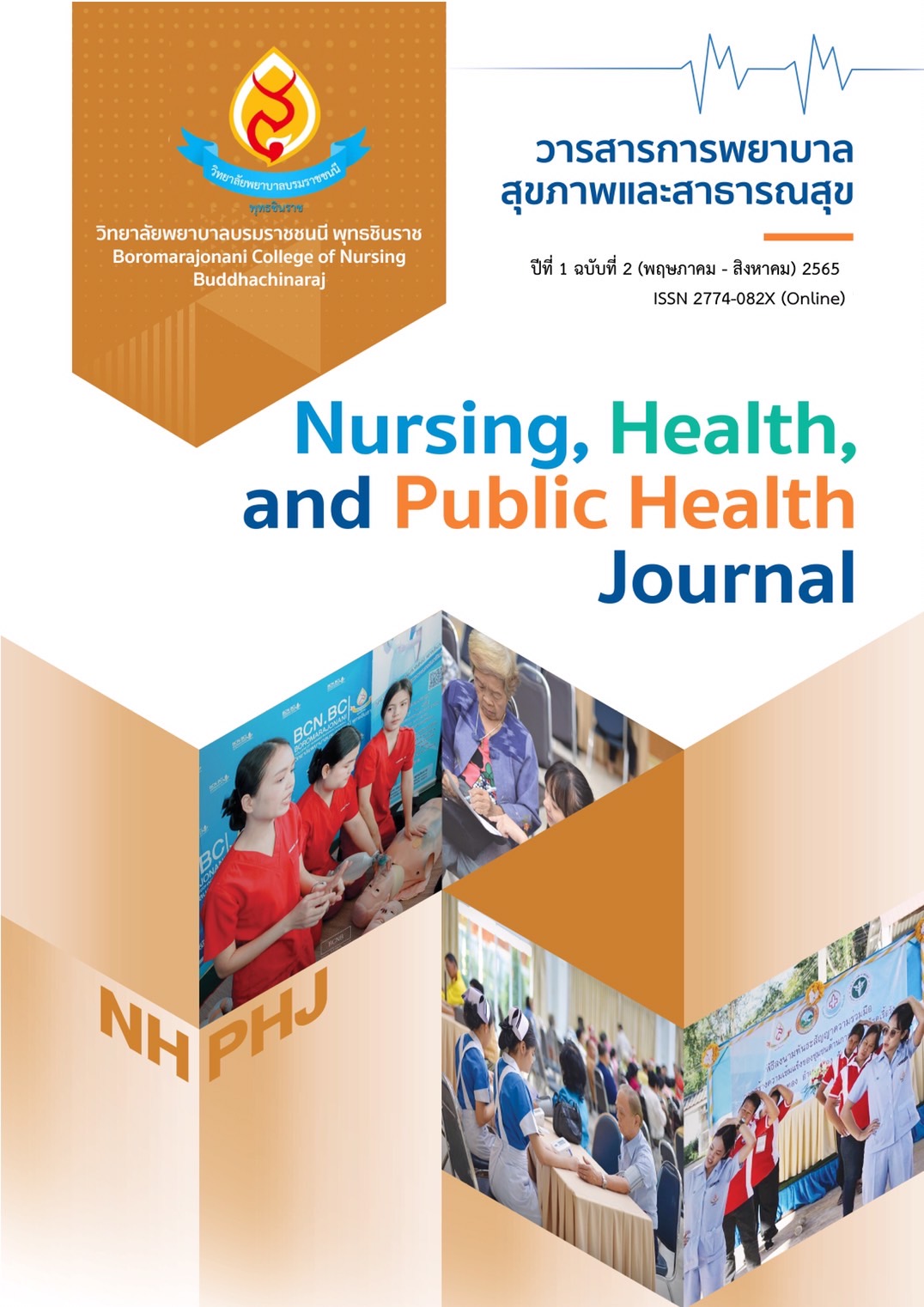A Development of Care the Patients with Septicemia at Patients one female medicine ward, Buddhachinaraj Phitsanulok Hospital
Keywords:
Developing nursing care guidelines, Nursing care, Patients with septicemiaAbstract
The purposes of this research and development were to develop and examine the effects of guidelines for caring patients with septicemia. The research was divided into 3 phases: 1) the situation analysis phase by studying the related documents and group discussion, 2) the development phase of care guidelines for patients with septicemia, and 3) the evaluation phase of the care guidelines. The subjects were 15 professional nurses and 30 patients. Qualitative data were analyzed by content analysis, and quantitative data were analyzed by frequency, percentage, mean, standard deviation, chi-square, paired t-test, and Wilcoxon Signed Ranks Test, with statistical significance at the level of 0.05
The situation analysis results revealed that there were 3 problems, including 1) administration, 2) operation, and 3) support. These lead to the development of guidelines for caring the patients with septicemia, consisting of 3 components: 1) supervising the caring for patients with septicemia, 2) nursing skills in nursing care for patients with septicemia, and 3) process of caring for patients with septicemia. Using PDCA quality management concepts, the study found that patients who received resuscitation in 1 hour after developing the care guideline were significantly more than those before. In addition, incidences of organ failure and death were less than those before the developing care guideline. Furthermore, after developing the care guideline, median scores of nursing practice knowledge of professional nurses were significantly higher than those before the guideline development (p=0.001). In addition, the mean scores of nursing practice after developing the guidelines were significantly higher than those before the development (p<0.001). Therefore, this care guideline can be applied as a guideline to improve nursing quality, and patients will be safer.
References
กระทรวงสาธารณสุข. (2564). อัตราตายผู้ป่วยติดเชื้อในกระแสเลือดแบบรุนแรงชนิด community-acquired. สืบค้นเมื่อ 25 เมษายน 2565 จาก http://healthkpi.moph.go.th/kpi2/kpi/index/?id=1448
กรรณิกา อำพนธ์, ชัชญาภา บุญโยประการ, และพัชรินทร์ ศิลป์กิจเจริญ. (2560). ผลลัพธ์ของการพัฒนาการดูแลผู้ป่วยติดเชื้อในกระแสเลือดโรงพยาบาลพระปกเกล้า.วารสารศูนย์การศึกษาแพทยศาสตร์คลินิก โรงพยาบาลพระปกเกล้า, 34(3), 222-234.
กลุ่มงานอายุรกรรม. (2562). แนวปฏิบัติการดูแลผู้ป่วยติดเชื้อในกระแสเลือด. พิษณุโลก: โรงพยาบาล พุทธชินราช พิษณุโลก.
ฑิตยา วาระนัง. (2562). ผลลัพธ์ของการใช้แนวปฏิบัติการดูแลผู้ป่วยที่มีภาวะติดเชื้อในกระแสโลหิต โรงพยาบาลฝาง จังหวัดเชียงใหม่. เชียงรายเวชสาร, 11(1), 1-8.
ทิฏฐิ ศรีวิสัย และ วิมล อ่อนเส็ง. (2560). ภาวะช็อกจากการติดเชื้อ: ความท้าทายของพยาบาลฉุกเฉิน. วารสารวิทยาลัยพยาบาลบรมราชชนนี อุตรดิตถ์, 9(2), 152-162.
บดินทร์ภัทร์ สายบุตร. (2562). กระบวนการพัฒนาระบบประกันคุณภาพการศึกษาตามวงจร PDCA ของมหาวิทยาลัยมหาจุฬาลงกรณราชวิทยาลัย. วารสารวิจัยวิชาการ, 2(1), 39-53.
ประกาศิต เทนสิทธิ์, ชยันตร์ธร ปทุมานนท์,สุขี พบลาภ, ชลิสา นันทสันติ และ ธนิตา มนตรี. (2563). ปัจจัยที่มีผลต่อการเสียชีวิตเร็วและช้าในผู้ป่วยติดเชื้อในกระแสเลือด. วารสารการแพทย์โรงพยาบาลบุรีรัมย์ ศรีสะเกษ สุรินทร์ บุรีรัมย์, 35(1), 101-109.
ปัญญา เถื่อนด้วงและนาตยา คำสว่าง. (2562). การพัฒนาระบบการพยาบาลผู้ป่วยติดเชื้อในกระแสเลือดแบบรุนแรง. พุทธชินราชเวชสาร, 36(2), 180-193.
โรงพยาบาลพุทธชินราช พิษณุโลก. (2562). สถิติบริการ โรงพยาบาลพุทธชินราช พิษณุโลก. พิษณุโลก: โรงพยาบาลพุทธชินราช พิษณุโลก.
ยุวดี เทียมสุวรรณ, อรชร มาลาหอม, ธีรนุช ยินดีสุข ประภัสสร, ควาญช้าง, และนุสรา ประเสริฐศรี. (2560). การพัฒนาระบบการดูแลผู้ป่วยติดเชื้อในกระแสเลือดในผู้ป่วยหนักโดยใช้การจัดการรายกรณี ในโรงพยาบาลสรรพสิทธิประสงค์. วารสารการพยาบาลและการดูแลสุขภาพ, 35(1), 184-192.
อรรถยา อมรพรหมภักดี, ฐาศุกร์ จันทร์ประเสริฐ, และอมราพร สุรการ. (2563). การนิเทศทางการพยาบาล: การทบทวนแบบกำหนดขอบเขต. วารสารพยาบาล กระทรวงสาธารณสุข, 30(3), 144-157.
Alberto, L., Marshall, A. P., Walker, R., & Aitken, L. M. (2017). Screening for sepsis in general hospitalized patients: A systematic review. Journal of Hospital Infection, 96(4), 305–315.
Amland, R. C., & Hahn-Cover, K. E. (2016). Clinical decision support for early recognition of sepsis. American Journal of Medical Quality, 31(2), 103–110.
Daniels, J. F. (2016). Purposeful and timely nursing rounds: A best practice implementation project. JBI Database System Rev Implement Rep, 14(1), 248-267.
McNab, D., Freestone, J., Black, C., Carson-Stevens, A., & Bowie, P.. (2018). Participatory design of an improvement intervention for the primary care management of possible sepsis using the functional resonance analysis method. BMC Med, 16(1), 174.
Schorr, C. (2018). Surviving sepsis campaign hour-1 bundle. Retrieved 2020 April 22, from: https://www.myamericannurse.com/surviving-
Singer, M, Deutschman, C. S., Seymour, C. W., Shankar-Hari, M., Annane, D., & Bauer, M. et al. (2016). The third international consensus definitions for sepsis and septic shock (Sepsis-3). Jama, 315(8), 801-810.
Downloads
Published
How to Cite
Issue
Section
License
Copyright (c) 2022 Boromarajonani College of Nursing Buddhachinaraj

This work is licensed under a Creative Commons Attribution-NonCommercial-NoDerivatives 4.0 International License.


